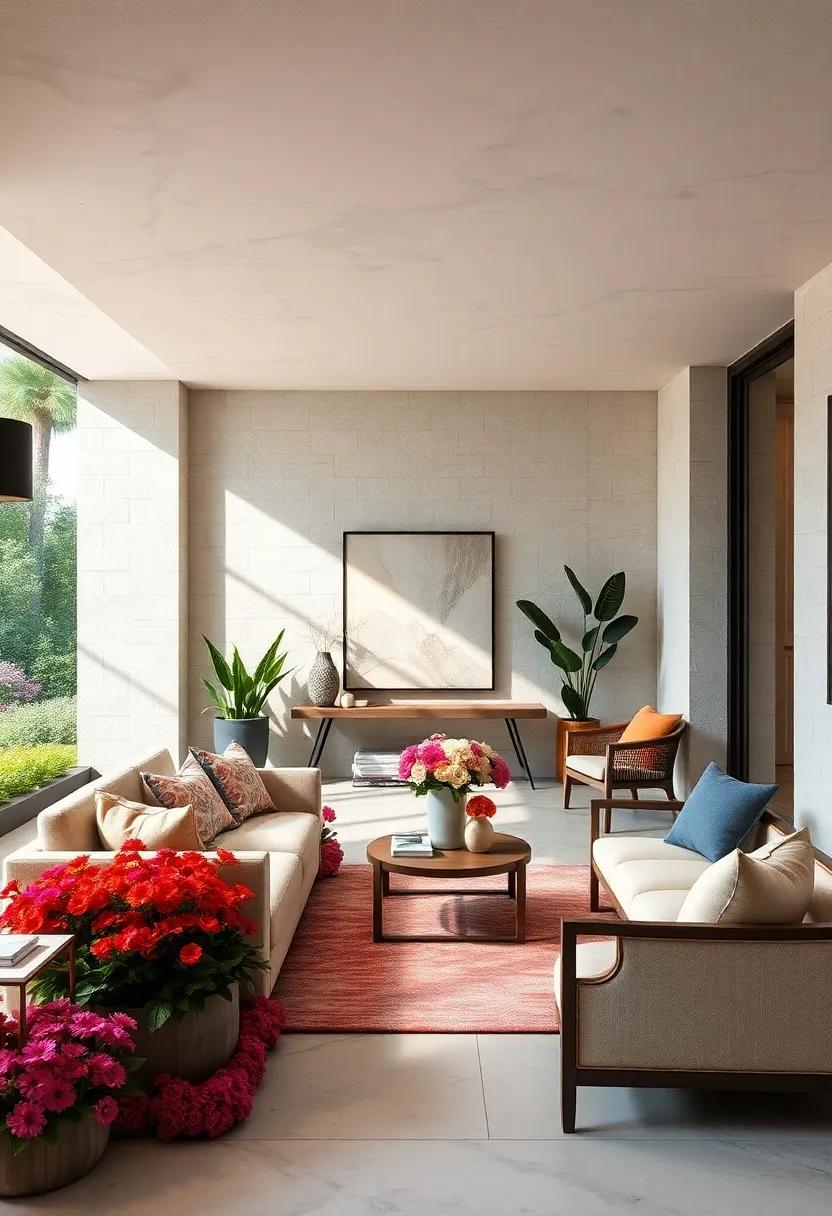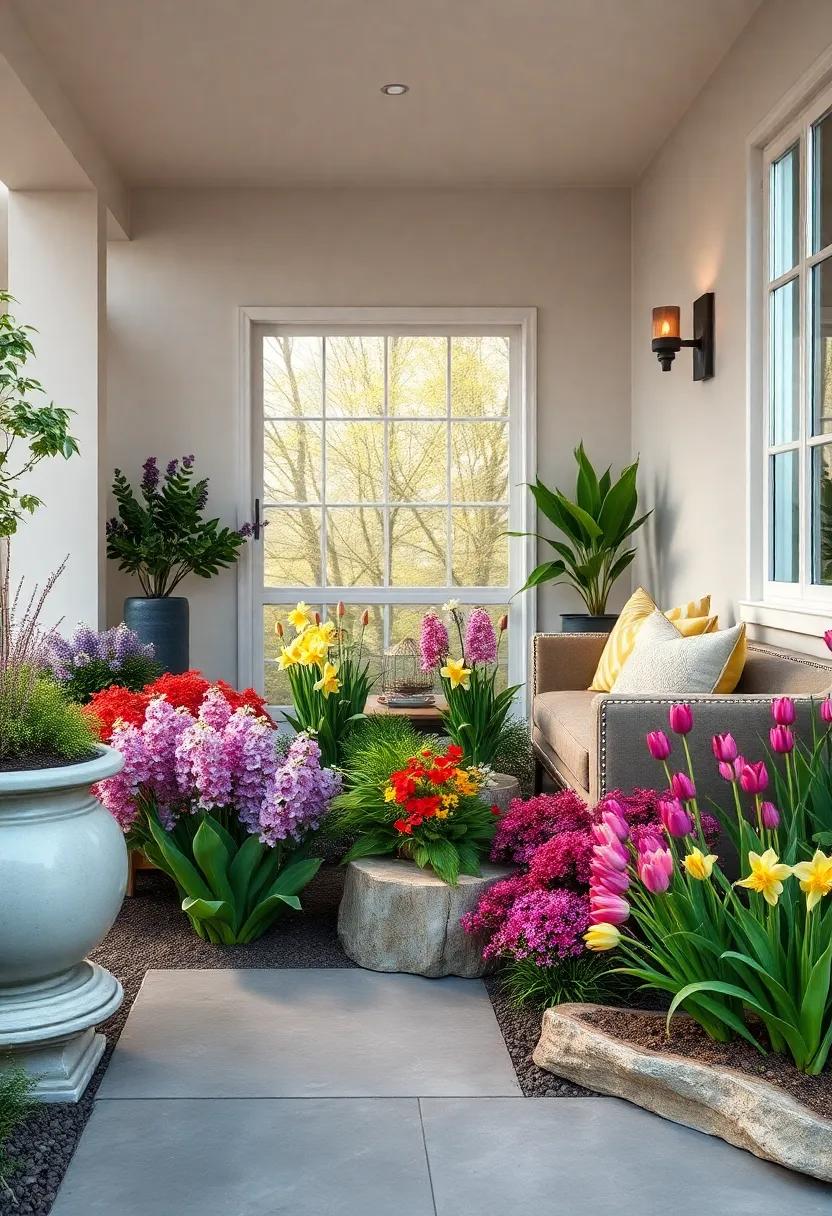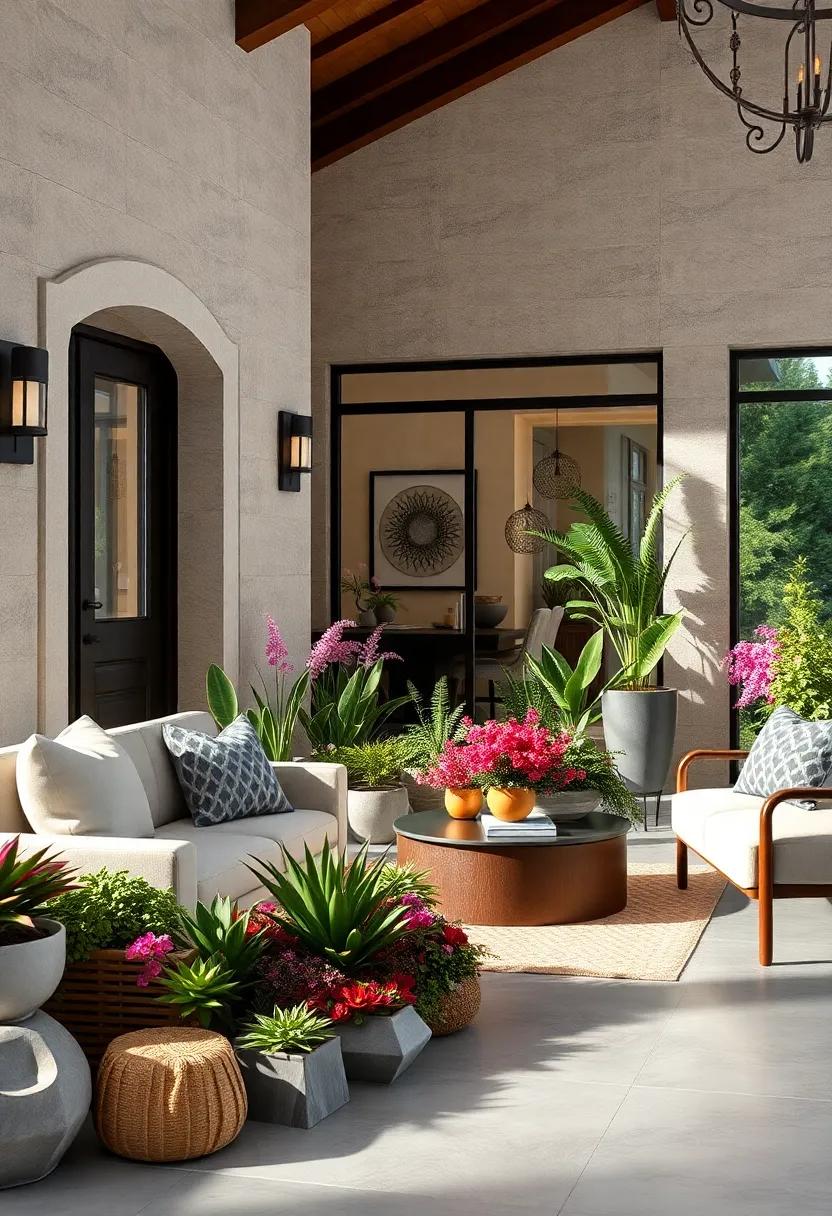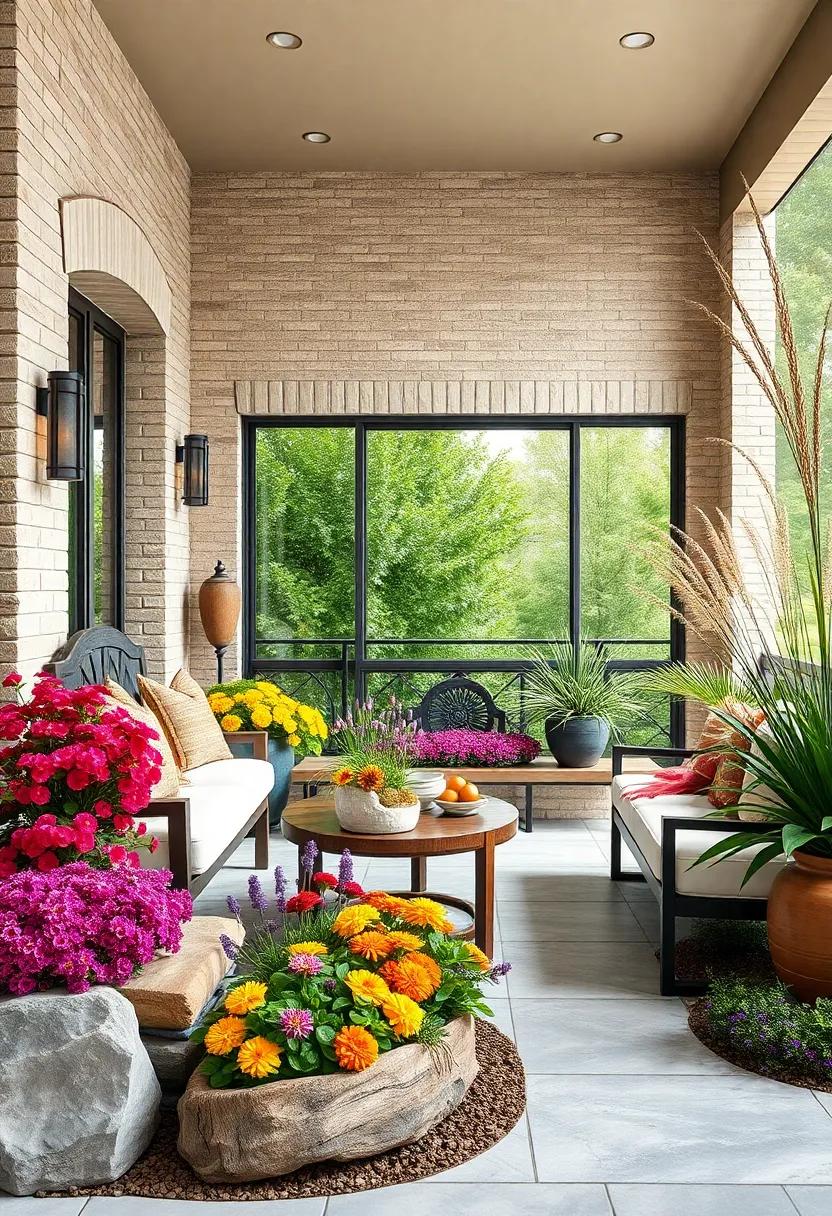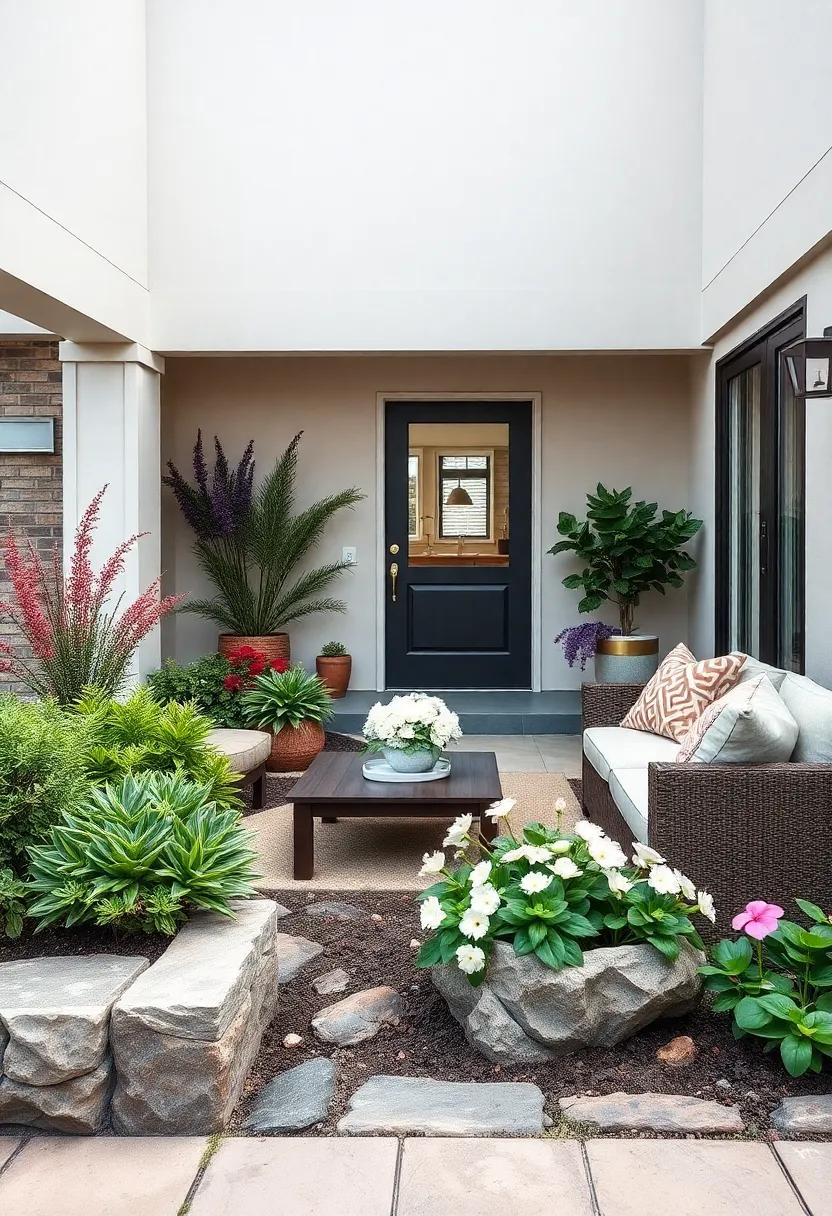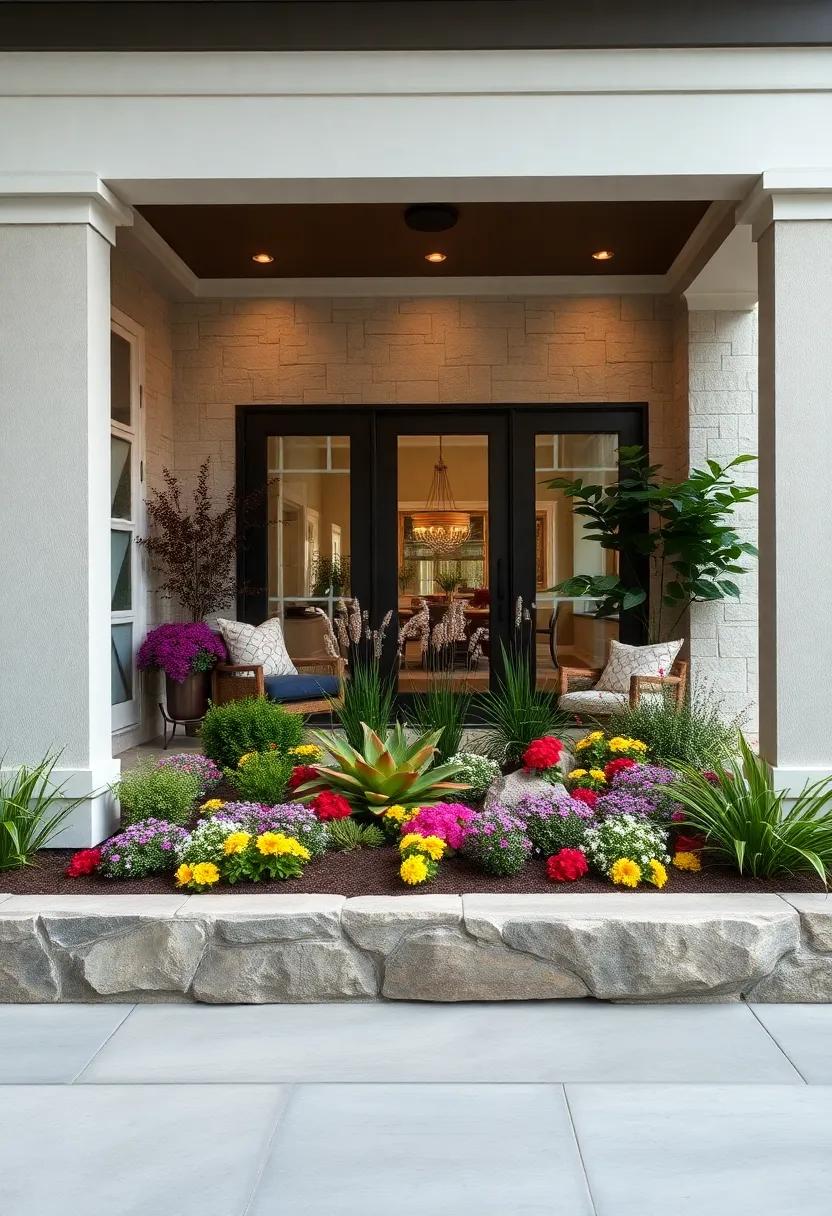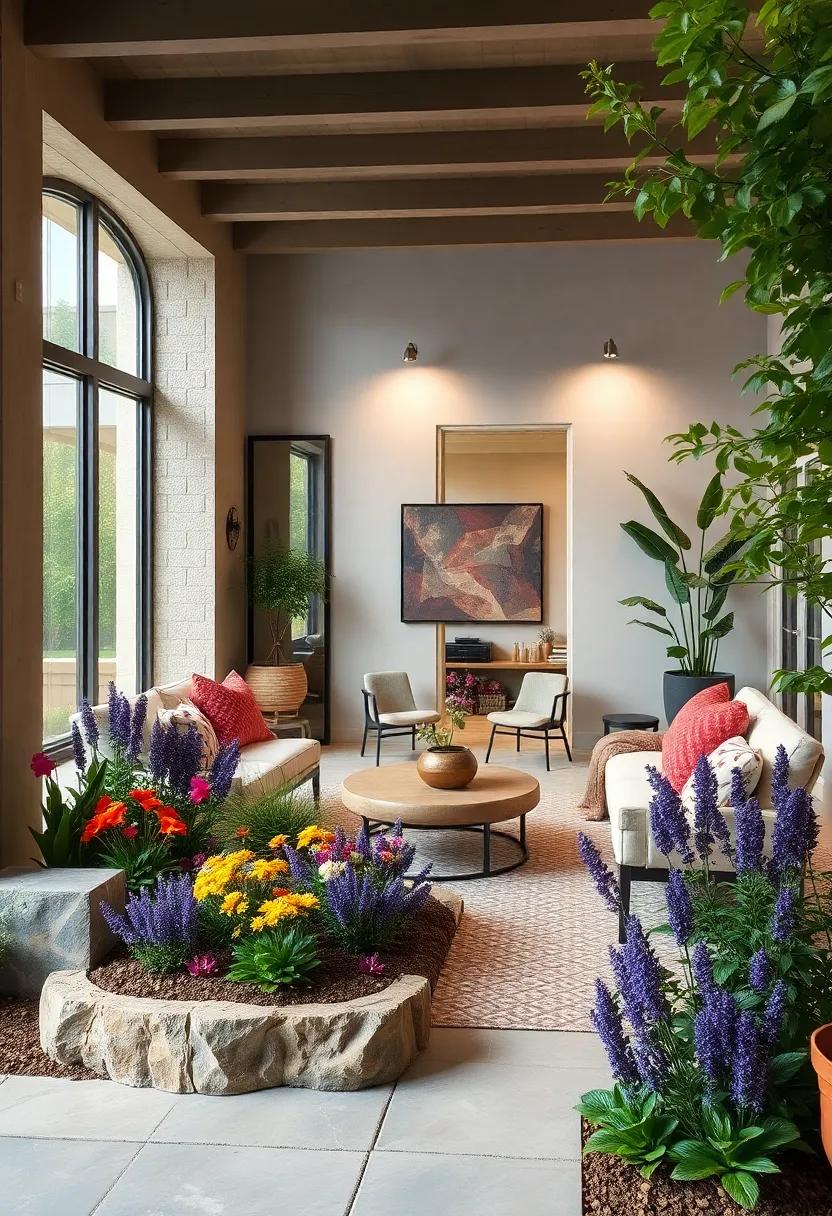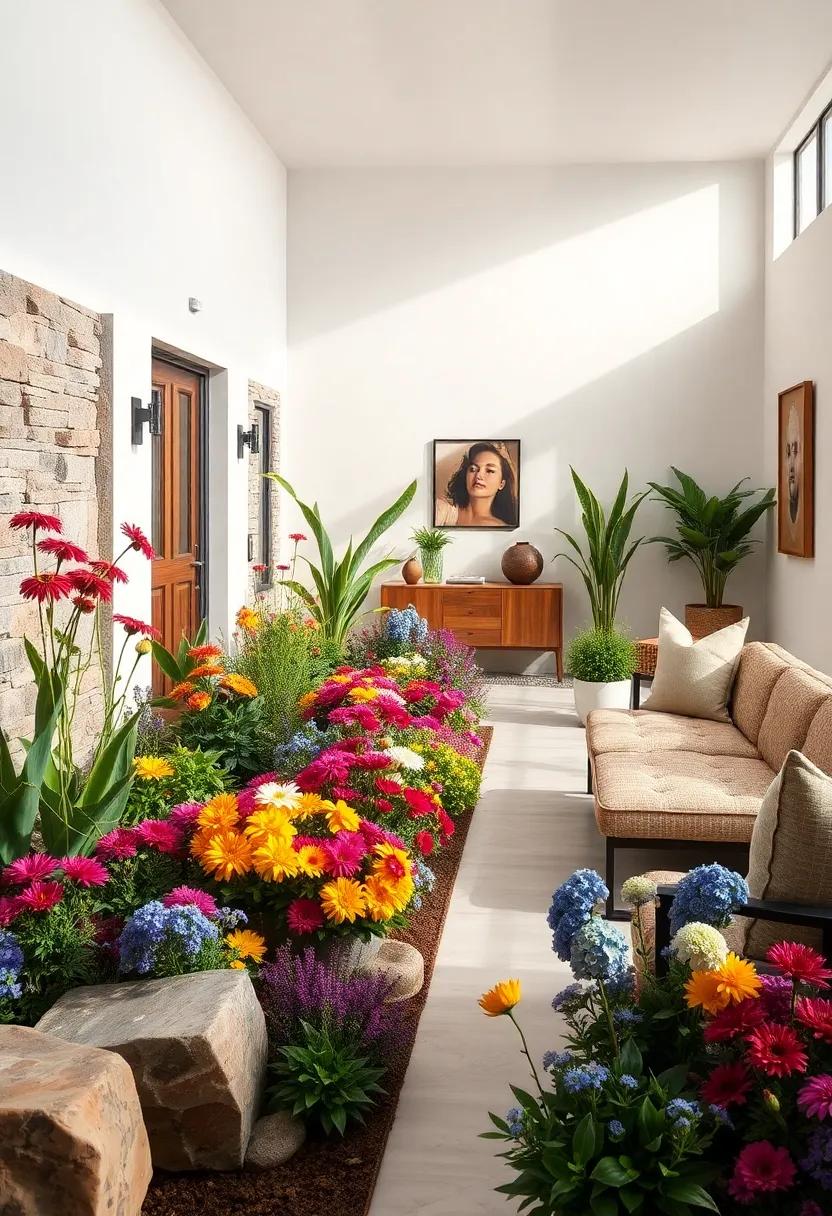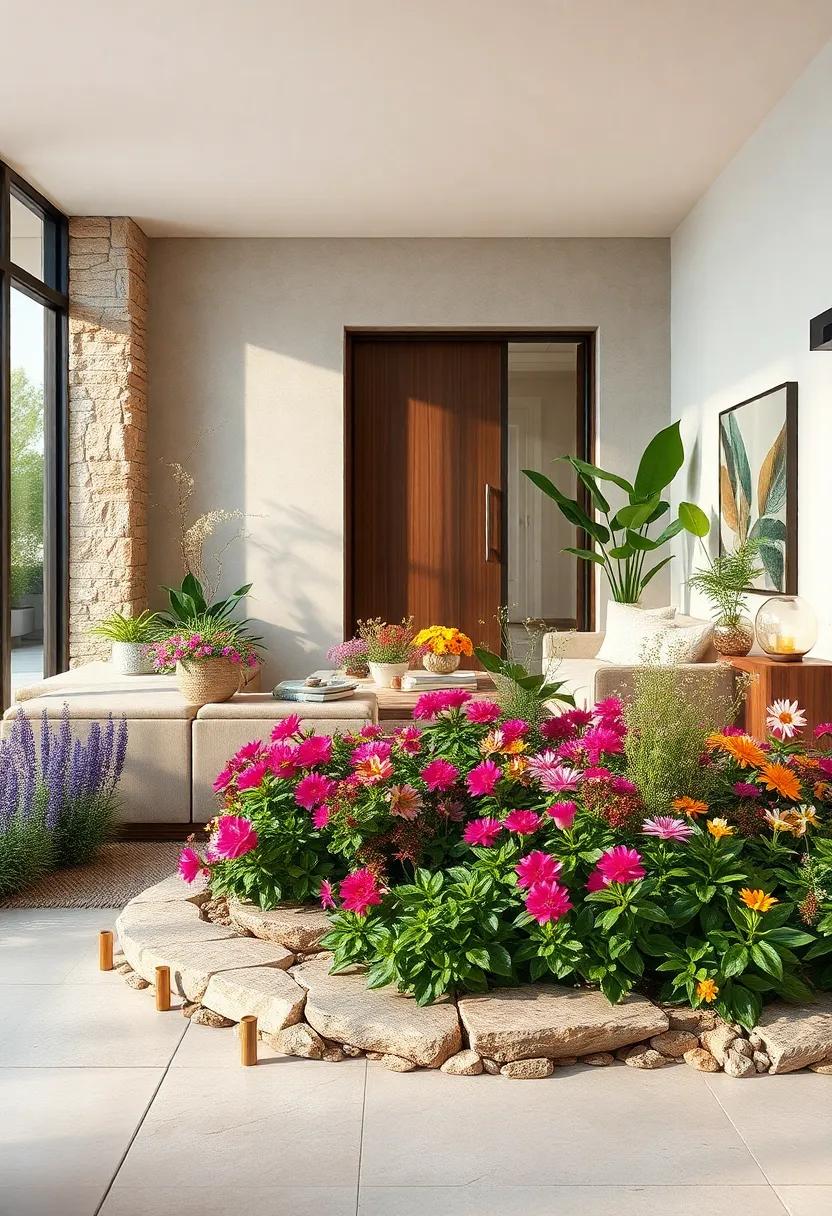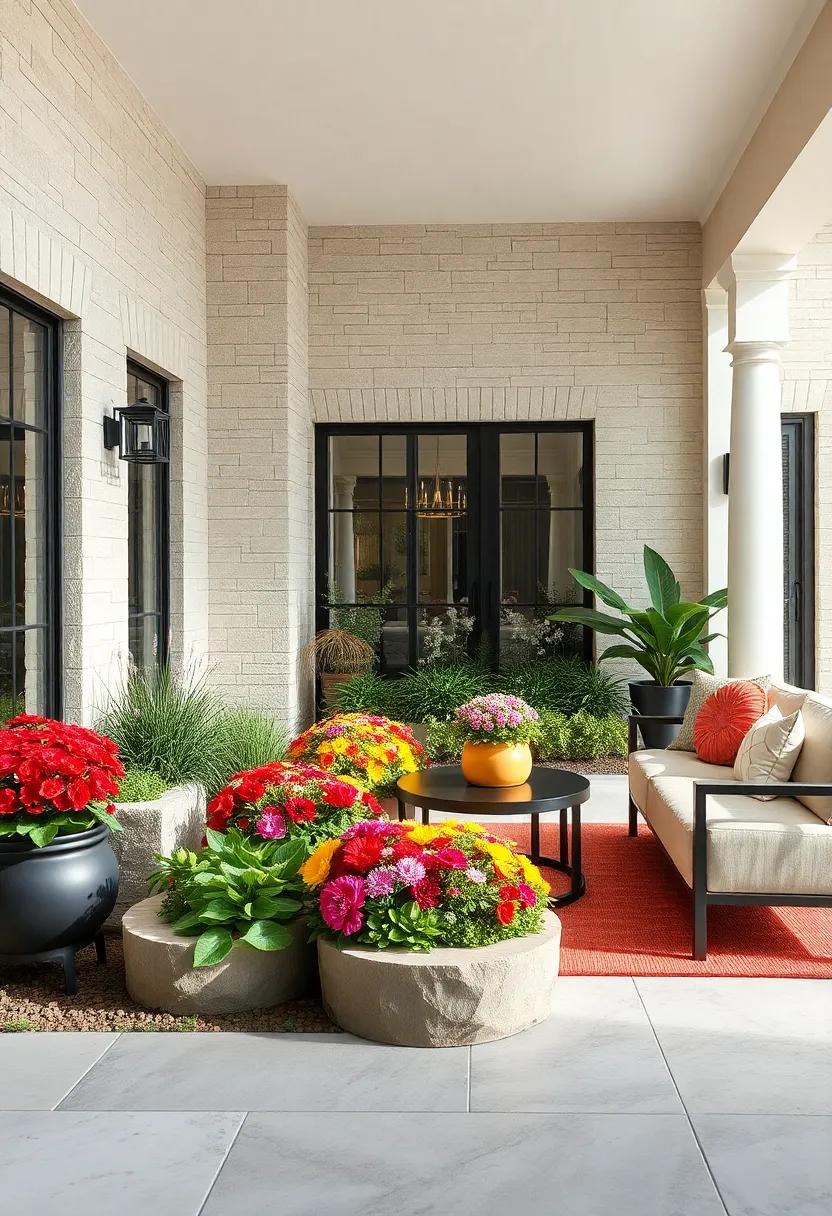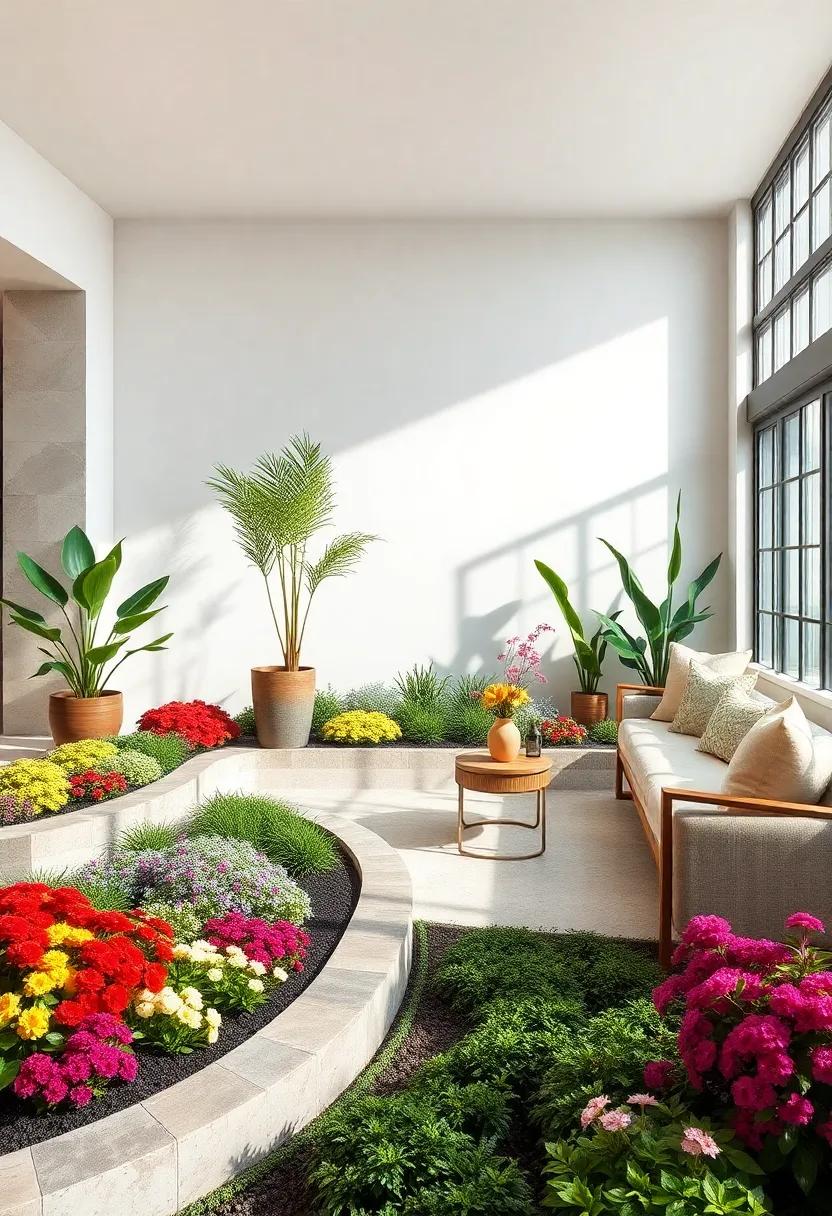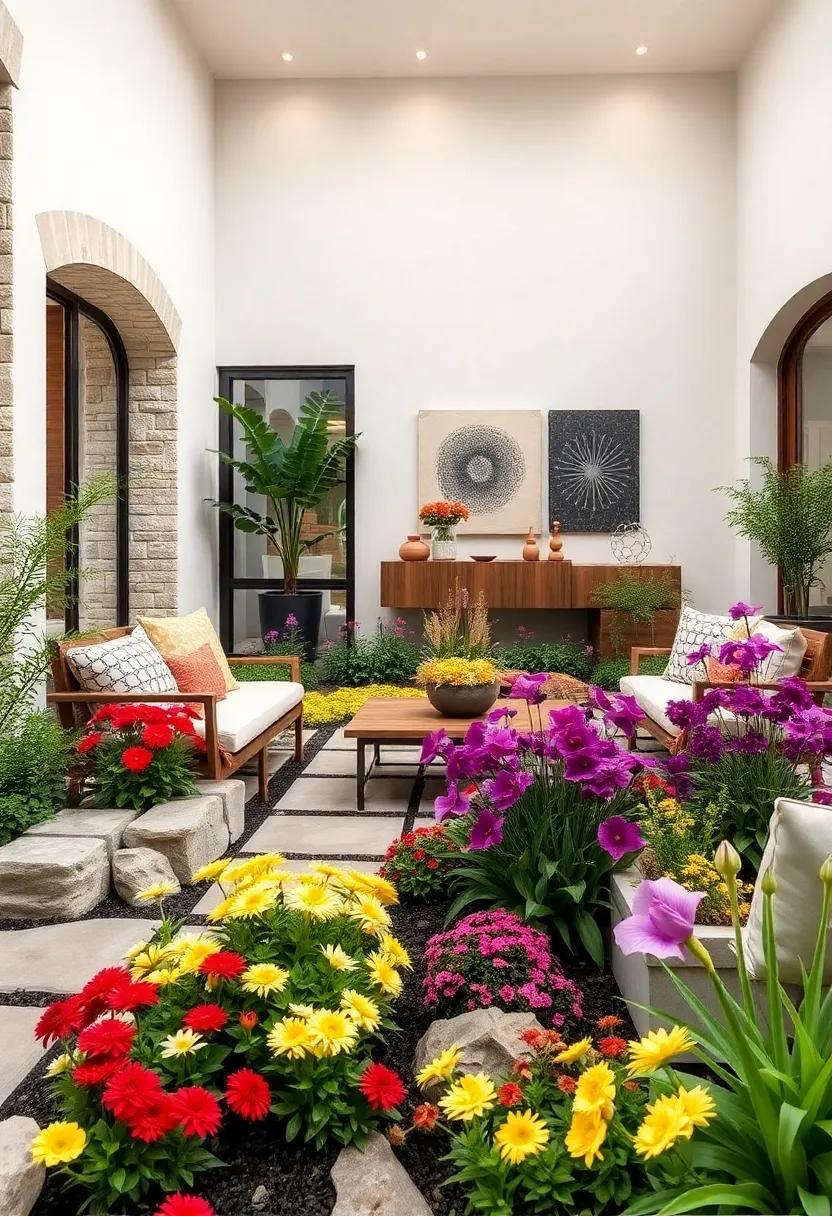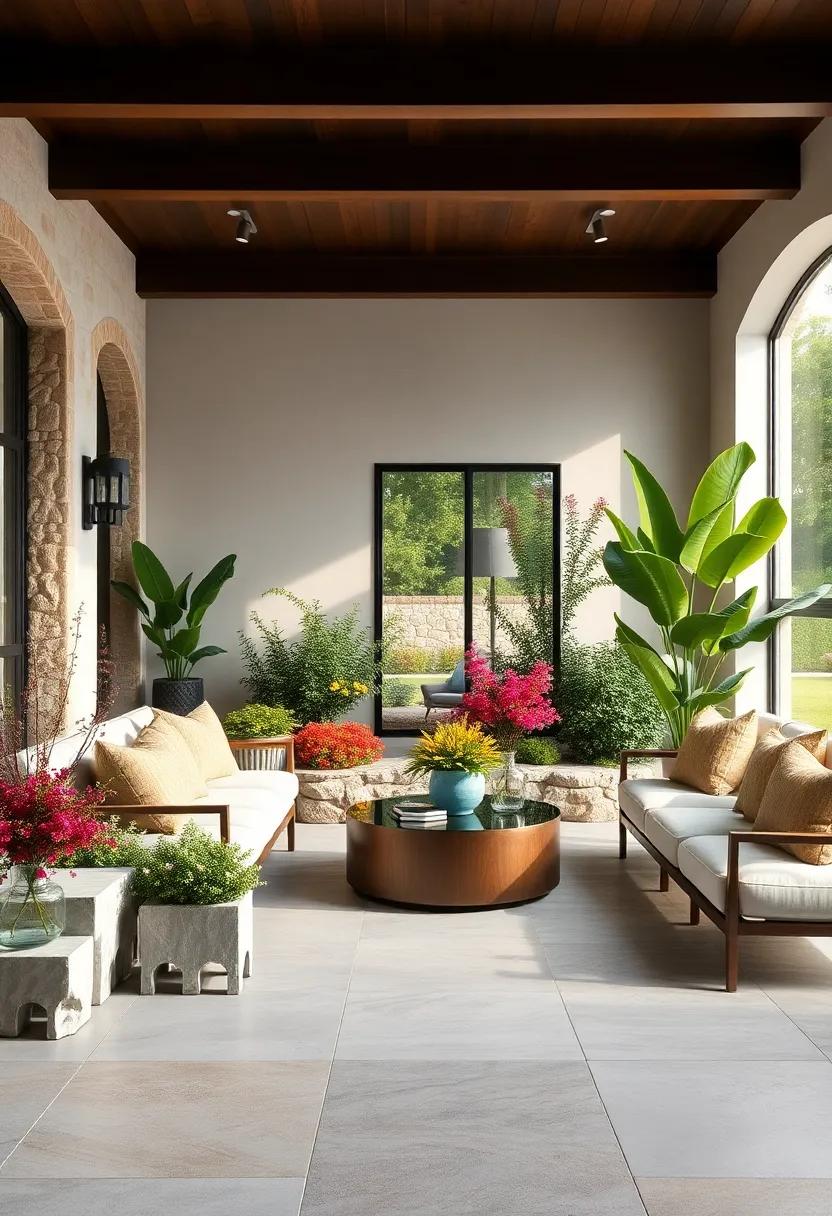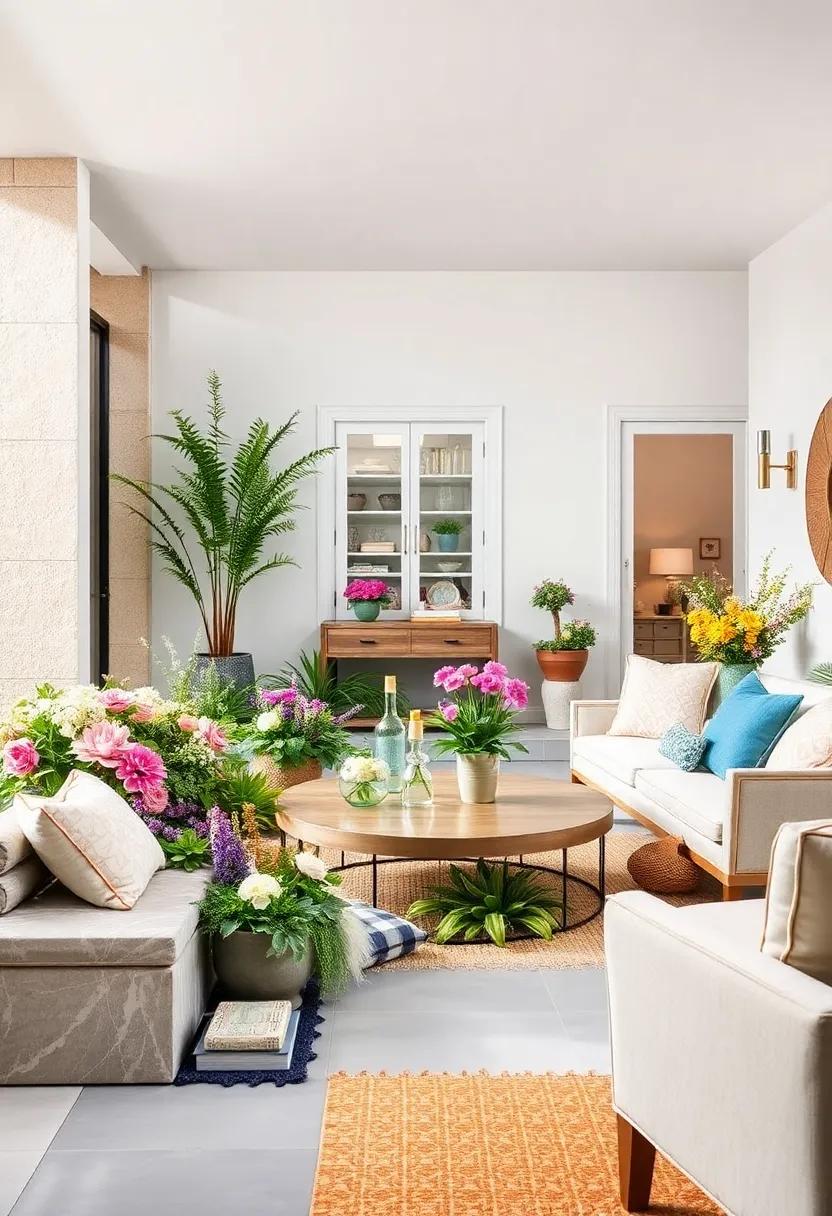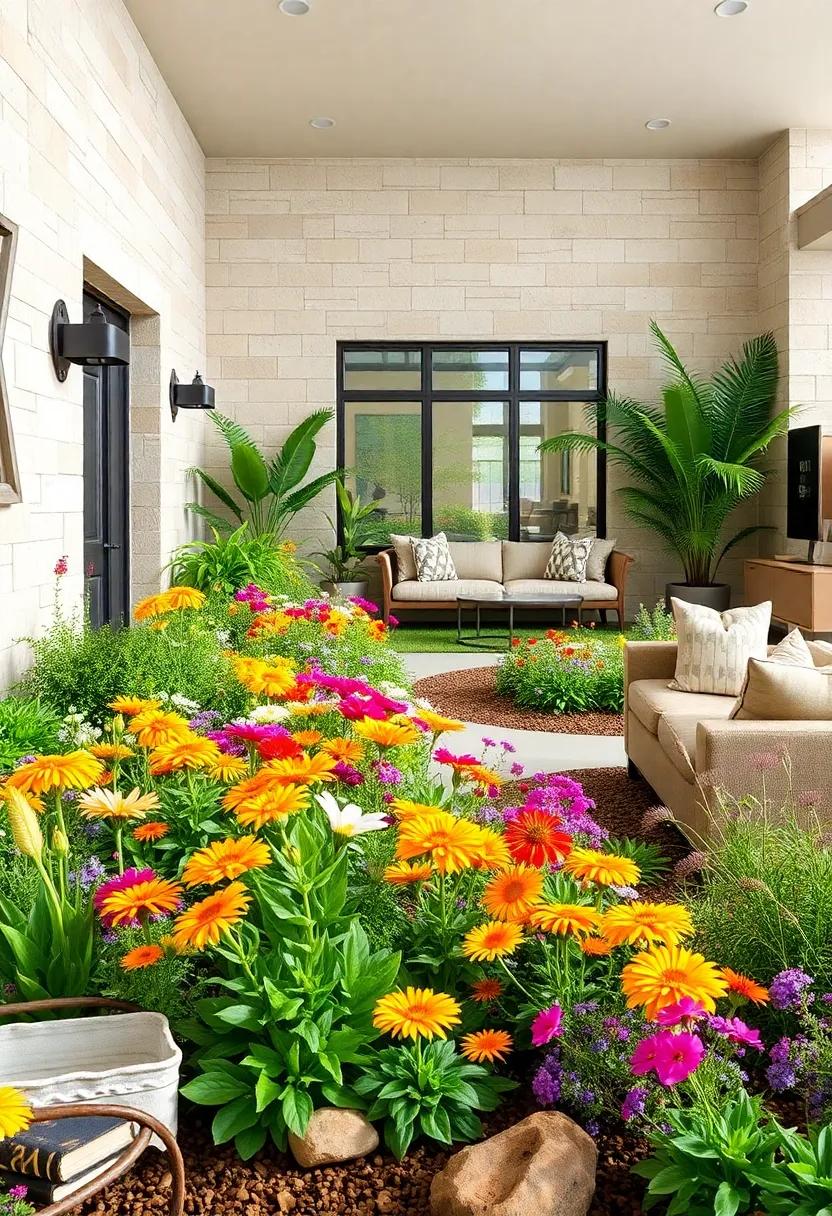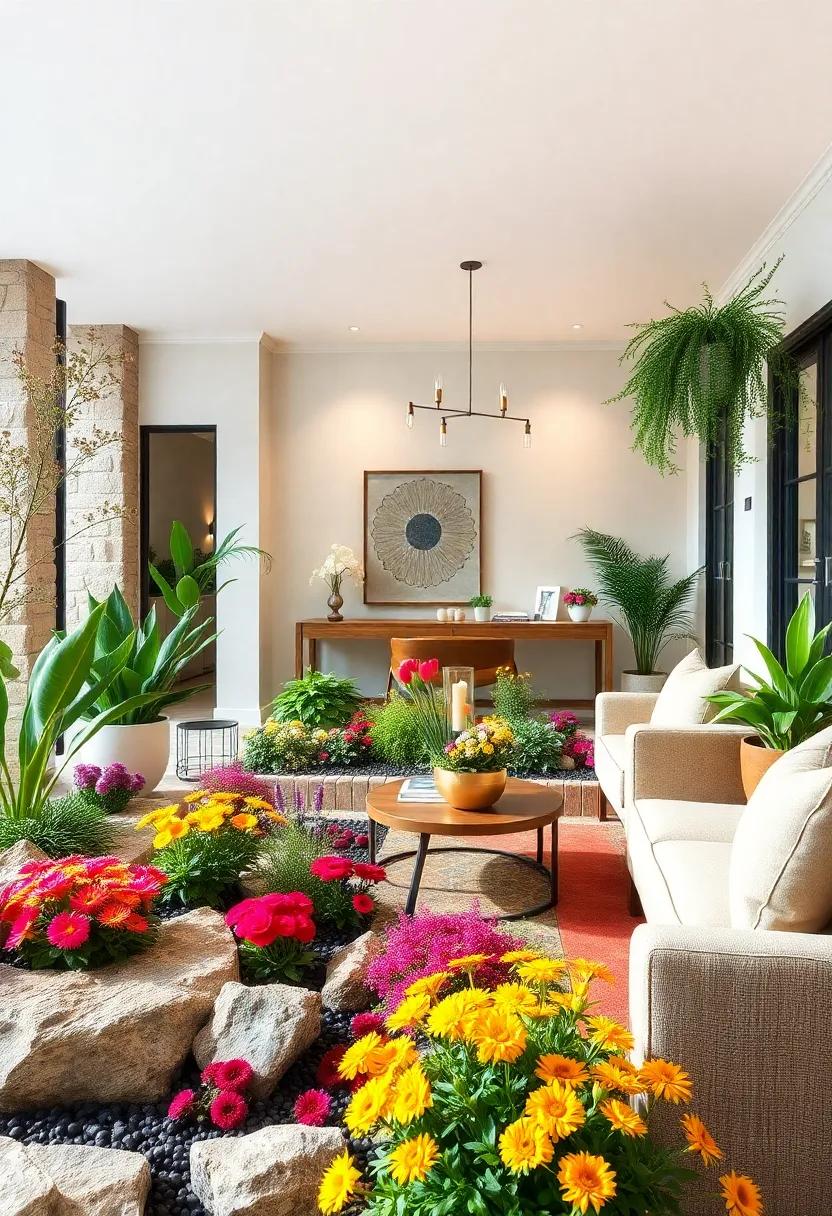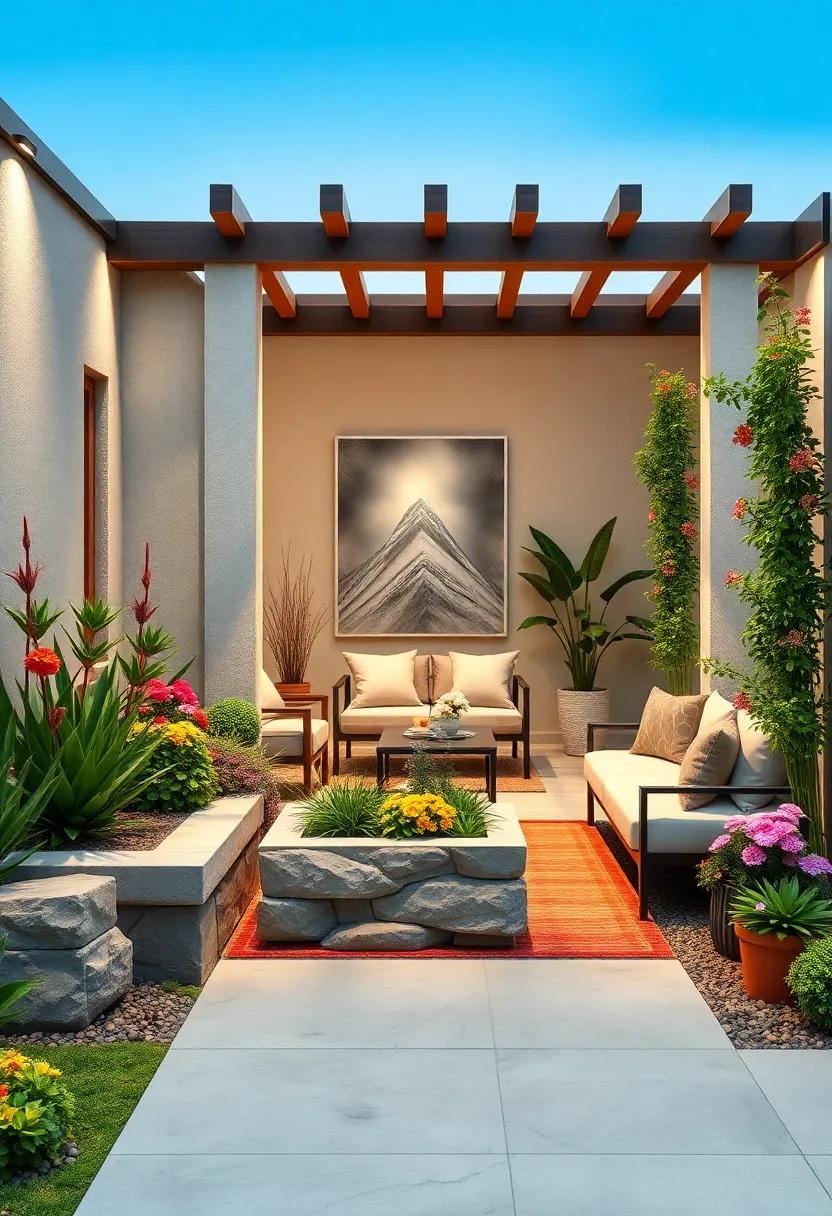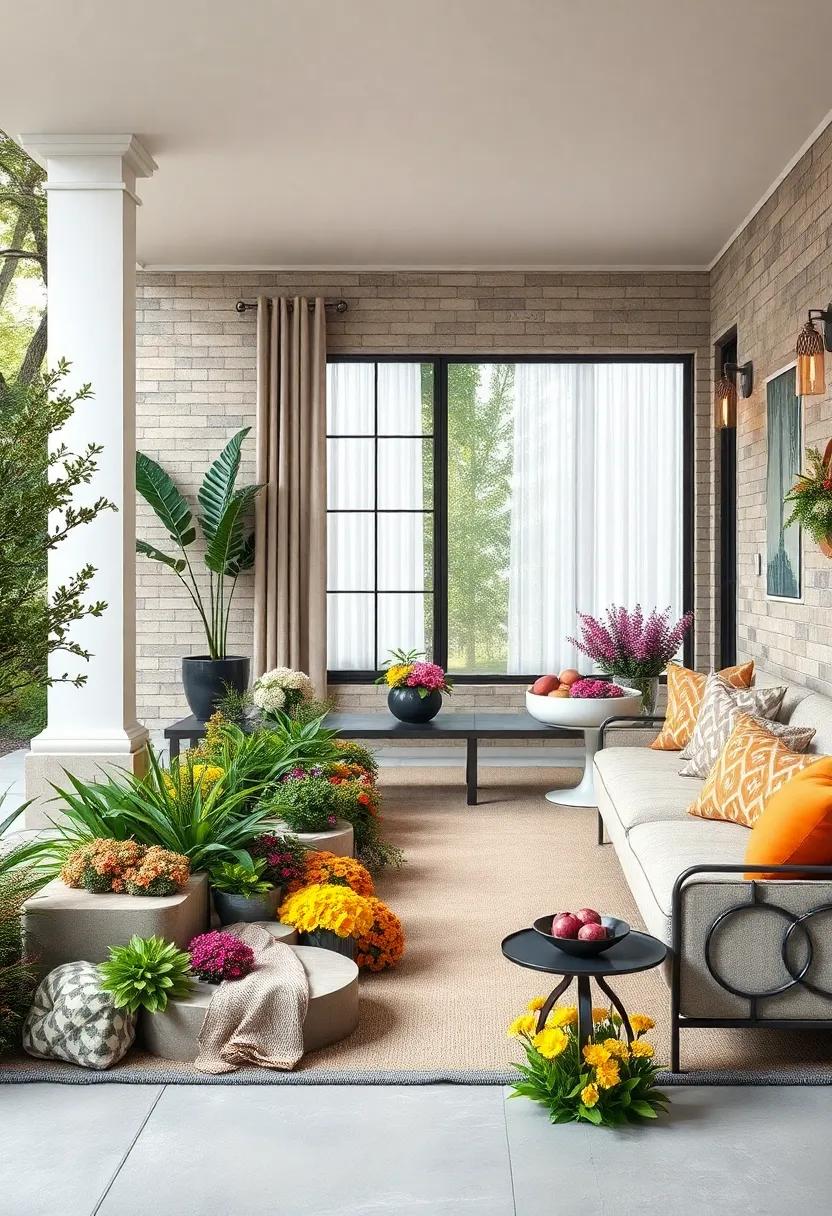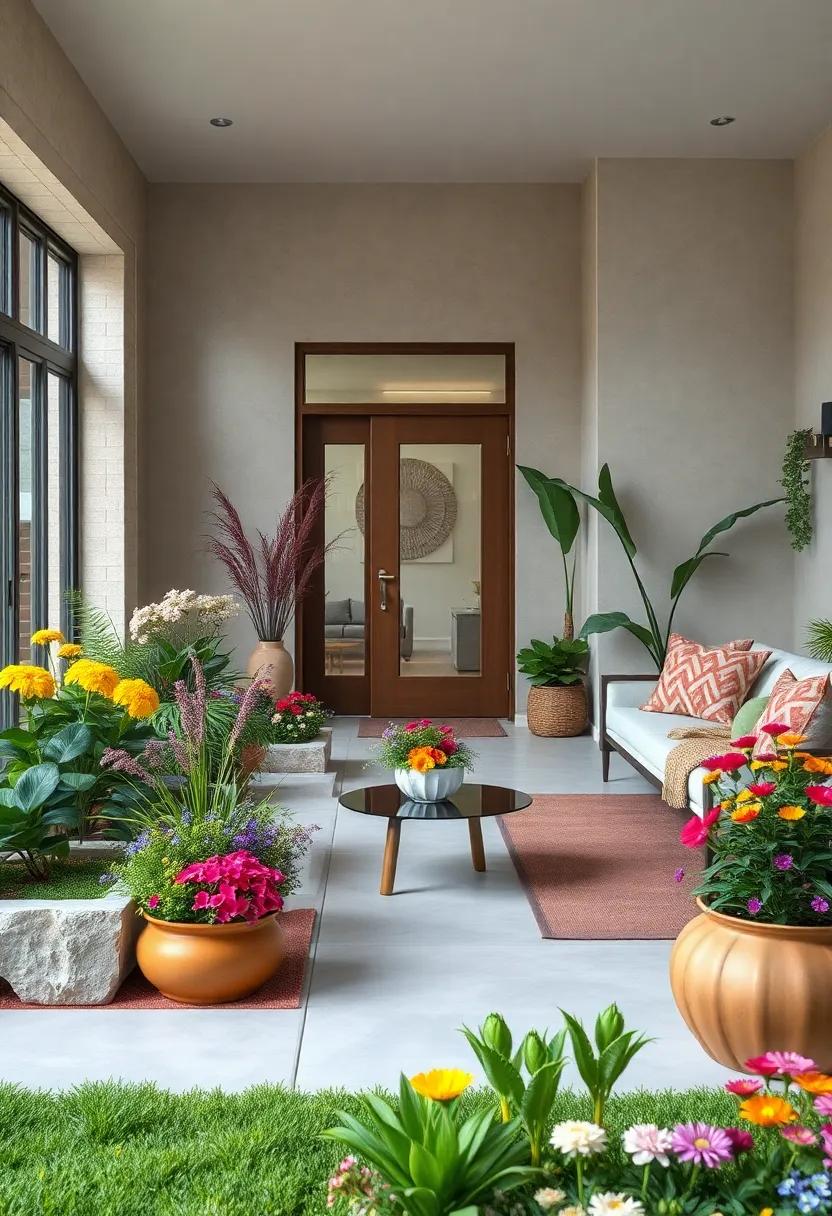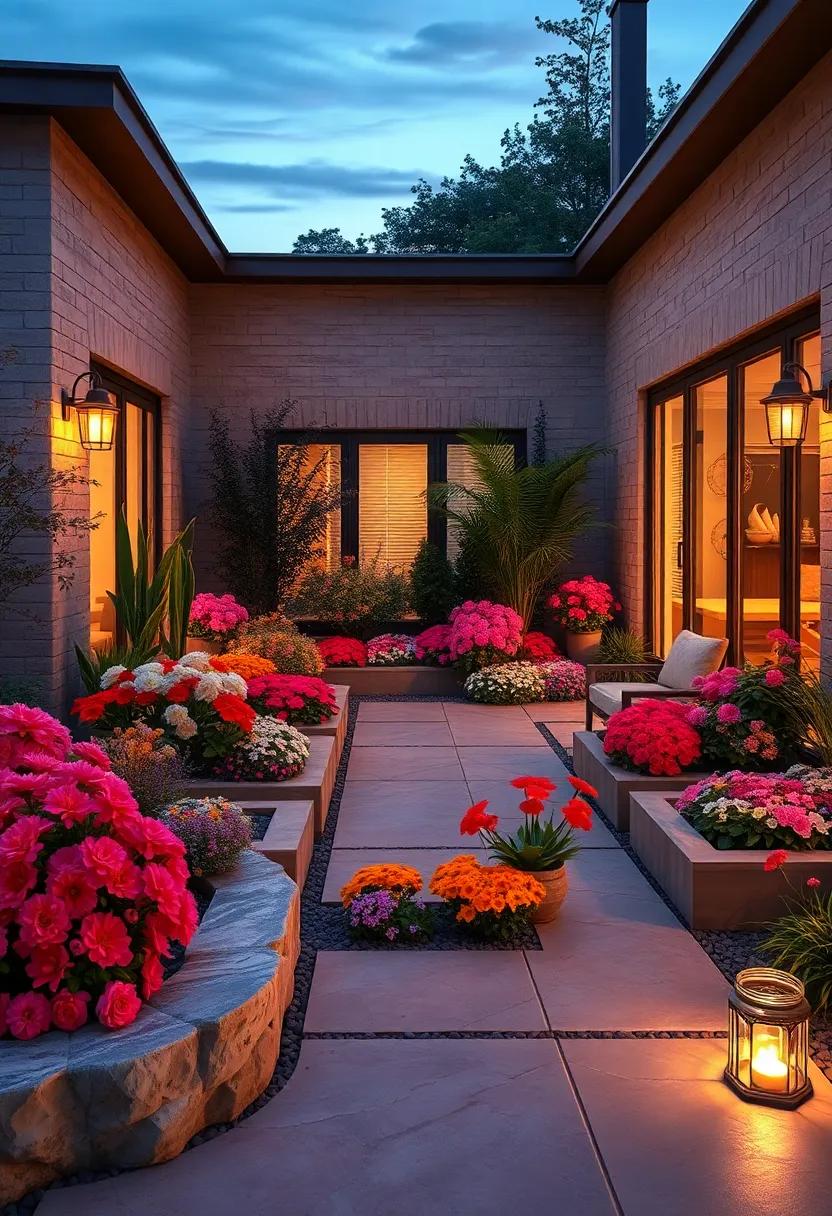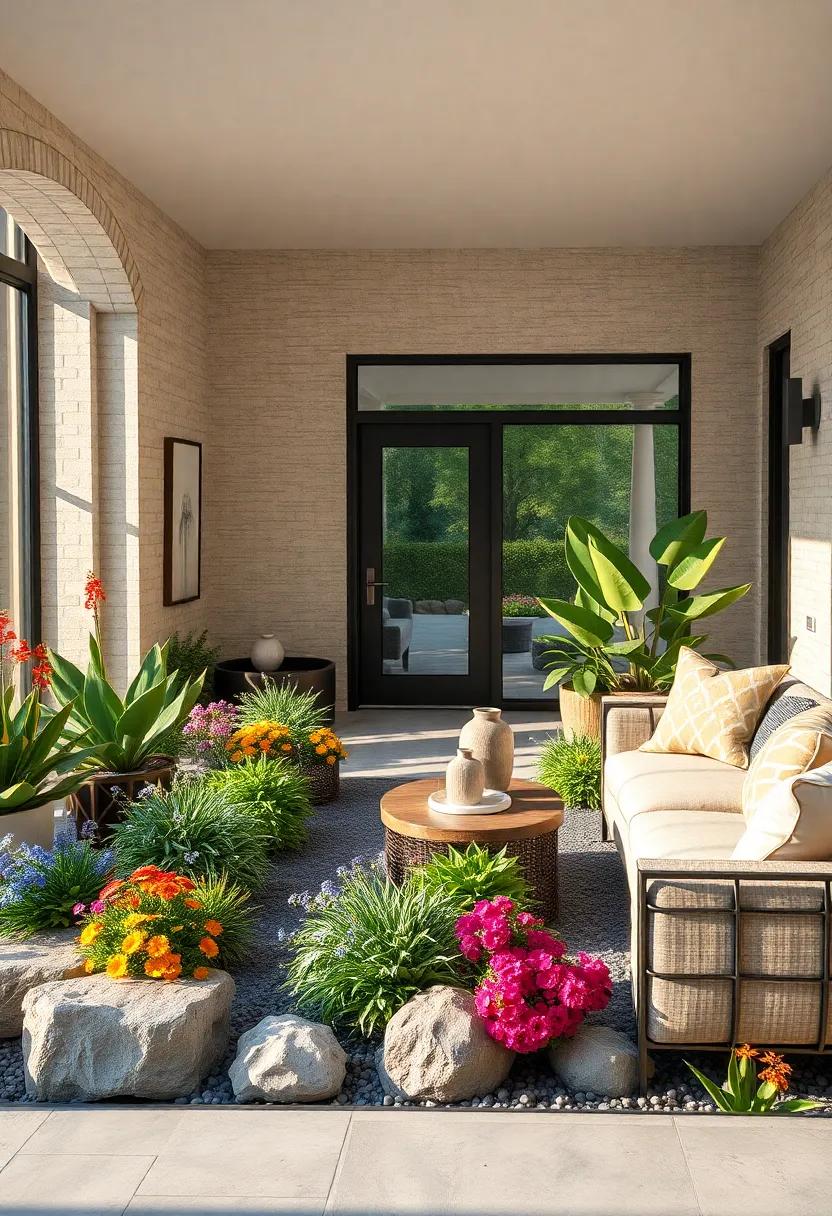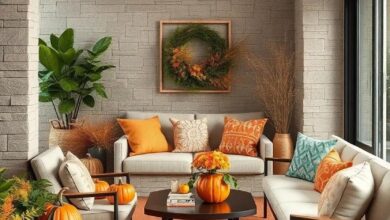Bloom Through the Year: Designing Seasonal Flower Beds for Front Yards
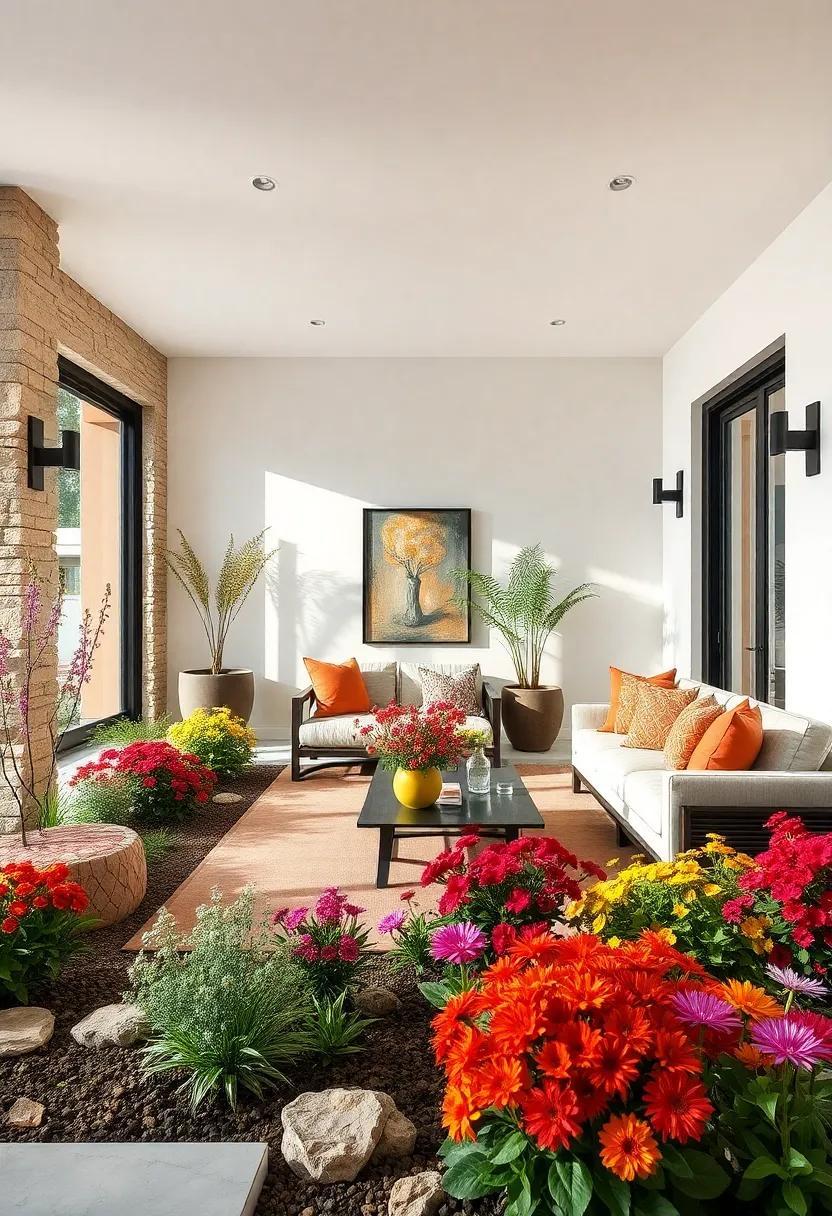
There’s something enchanting about a front yard that promises a vibrant display from the first thaw of spring to the gentle frost of winter. Designing seasonal flower beds speaks to that desire-a living canvas that evolves with the year, inviting neighbors and passersby to pause in admiration. “Bloom Through the Year” explores how thoughtful planning and a nuanced understanding of nature’s rhythms can transform your front yard into a harmonious blend of colors, textures, and fragrances that celebrate each season’s unique charm. Whether you’re a seasoned gardener or a curious beginner, this guide will inspire you to cultivate beauty that truly never fades.
Seasonal Color Palettes That Harmonize with Front Yard Architecture and Natural Surroundings
Choosing the right hues to complement your home’s façade and the surrounding landscape is essential for achieving a cohesive outdoor aesthetic. In spring, soft pastels like blush pink, lavender, and mint green breathe life into a classic cottage or a craftsman-style entrance. These gentle shades echo the tender new growth of early blooms, fostering a seamless transition from the natural world to your home’s architectural charm. As the seasons progress, shift towards vibrant reds, burnt oranges, and sunflower yellows-perfect for rustic farmhouse styles or Mediterranean villas, where bold colors embrace the warmth and earthiness of late summer.
Winter and autumn call for grounding palettes that reflect the subtle beauty of bare branches and frosted leaves. Incorporate deep purples, silvery grays, and rich burgundies to harmonize with stone or brick exteriors, while enhancing the textural contrast between architecture and dormant gardens. Below is a simple reference guide to seasonal palette strategies for various front yard styles:
| Season | Ideal Palette | Architectural Styles |
|---|---|---|
| Spring | Pastel Pink, Lavender, Mint | Cottage, Craftsman, Colonial |
| Summer | Bright Red, Sunflower Yellow, Orange | Farmhouse, Mediterranean |
| Autumn | Burgundy, Copper, Mustard | Rustic, Tudor, Victorian |
| Winter | Deep Purple, Silvery Gray, Evergreen | Stone, Brick, Modern Minimalist |
Elegant Spring Blooms Featuring Hyacinths, Tulips, and Daffodils in Vibrant Front Garden Displays
Imagine stepping into your front yard to be greeted by a harmonious symphony of purple hyacinths, crimson tulips, and golden daffodils, each flower contributing its own charm and fragrance. These springtime gems don’t just offer vivid color; they transform your garden into a vibrant tableau that invites bees, butterflies, and passersby alike to pause and admire. Planting these bulbs in clusters or weaving them through existing greenery creates a layered effect, balancing bold statements with subtle accents. The fragrant hyacinths can be positioned near walkways for an aromatic welcome, while the tulips and daffodils provide pops of joyful color throughout the beds.
To optimize growth and achieve a dynamic bloom sequence, consider combining these blooms with early spring foliage and ground covers. The following list highlights practical planting tips for a thriving and elegant spring display:
- Pre-soaked hyacinth bulbs establish more quickly and enhance scent release.
- Tulip varieties with staggered bloom times extend the color show well into late spring.
- Daffodils naturally deter pests, reducing reliance on chemicals around other sensitive plants.
- Complementary foliage, such as hostas or ferns, provides greenery once flowers fade.
| Flower | Bloom Time | Light Needs | Height |
|---|---|---|---|
| Hyacinth | Early to Mid-Spring | Full Sun to Partial Shade | 6-12 inches |
| Tulip | Mid to Late Spring | Full Sun | 10-24 inches |
| Daffodil | Early to Mid-Spring | Full Sun to Partial Shade | 8-20 inches |
Summer Front Yard Beds Bursting with Sun-Loving Flowers Like Marigolds, Zinnias, and Petunias
Brighten your summer front yard with an explosion of colors that only sun-loving blooms can deliver. Marigolds, with their fiery orange and sunny yellow hues, are not only visually striking but also serve as natural pest repellents, keeping your garden healthy throughout the warm months. Zinnias add a playful pop of vibrant pinks, reds, and purples, attracting butterflies and pollinators to your outdoor sanctuary. Meanwhile, petunias offer a soft cascade of blossoms that fill spaces with delicate charm and a touch of elegance. By thoughtfully combining these resilient flowers, you craft a tapestry of textures and tones that celebrate the warmth and light of the season.
For a visually balanced planting scheme, consider layering your flower beds to maximize impact and bloom longevity. Use this simple guide to arrange your sun-loving flowers for a stunning summer display:
| Plant | Height | Color Palette | Bloom Time |
|---|---|---|---|
| Marigolds | 12-18 inches | Orange, Yellow, Gold | June to October |
| Zinnias | 6-24 inches | Pink, Red, Purple | July to September |
| Petunias | 6-12 inches | Lavender, White, Pink | June to October |
By mixing heights and colors, you create layers of interest that draw the eye across your garden. This approach encourages a harmonious rhythm of blooms that will last well into the fall, inviting vibrant life to your front yard every sunny day.
Rich Autumnal Tones Showcasing Chrysanthemums, Asters, and Ornamental Grasses in Cozy Front Gardens
As the days shorten and the air turns crisp, front gardens become canvases painted with rich shades of amber, rust, and deep burgundy. The blend of chrysanthemums, asters, and ornamental grasses weaves an inviting tapestry that exudes warmth and texture. Chrysanthemums bring vibrant pops of gold and violet, their layered petals creating a dramatic contrast against the wispy, flowing movements of ornamental grasses. Meanwhile, asters complement the scene with star-like blooms in soft purples and pinks, lending both charm and depth. This triad not only enhances visual appeal but also invites butterflies and bees to linger in the cool light of autumn afternoons.
For gardeners seeking to maximize impact in smaller front yard spaces, combining these plants with thoughtfully chosen evergreens and late-season perennials can extend interest well into the colder months. Below is a quick guide to effectively pairing these favorites for a seamless seasonal display:
| Plant | Color Highlights | Texture | Best Placement |
|---|---|---|---|
| Chrysanthemums | Gold, Red, Purple | Dense, Rounded | Front or Center Beds |
| Asters | Lavender, Pink, Blue | Delicate, Starry Blooms | Mixed Borders |
| Ornamental Grasses | Beige, Bronze, Green | Airy, Tall | Background or Edges |
Winter Front Yard Charm with Evergreens, Hellebores, and Hardy Pansies Adding Subtle Floral Interest
Transform your winter front yard into a serene sanctuary by blending evergreens with delicate bursts of color from hellebores and hardy pansies. These steadfast plants thrive where many others fade, ensuring your landscape remains inviting even amid the chill. Evergreens provide a rich, textured backdrop, their deep greens creating a natural frame that brightens the snow-dusted ground. Amidst this verdant canvas, the subtle blossoms of hellebores introduce muted tones of soft pinks, purples, and creamy whites, adding intrigue without overwhelming the peaceful winter palette.
Complementing these, hardy pansies serve as cheerful accents, their vibrant petals popping through frosty mornings with resilience. Incorporate them strategically along walkways or clustered near foundations for maximum visual interest. Here’s a quick guide to the key players that elevate winter appeal:
| Plant | Winter Interest | Care Tips |
|---|---|---|
| Evergreens | Year-round greenery, texture | Prune lightly in late winter |
| Hellebores | Early blooms in muted colors | Partial shade, well-drained soil |
| Hardy Pansies | Bright color in cold weather | Full sun to partial shade, regular watering |
Layered Flower Bed Designs Combining Annuals and Perennials for Continuous Year-Round Front Yard Beauty
Creating a layered flower bed is like composing a living tapestry that evolves with the seasons. By artfully combining vibrant annuals with the steady charm of perennials, you ensure your front yard remains captivating from spring’s first blossom to winter’s quiet bloom. Begin with taller perennials such as delphiniums or
Understanding bloom times and growth habits is key to maintaining a continually flourishing bed. Here’s a quick guide on how to layer and schedule planting:
| Layer | Plant Type | Example Plants | Bloom Season |
|---|---|---|---|
| Back | Perennials | Delphiniums, Lupines | Late Spring – Early Summer |
| Middle | Perennials | Sedum, Aster | Late Summer – Fall |
| Front | Annuals | Marigolds, Petunias, Violas | Spring – Fall |
In addition to the right plant selection, layering helps create textural contrast and depth, treating your front yard like a dynamic canvas. Don’t hesitate to add ground covers or ornamental grasses for movement and to soften edges. Rotating annuals seasonally not only refreshes the palette but also maximizes blooming potential, turning your layered flower bed into a perennial spectacle of colors all year long.
Incorporating Fragrant Blooms Such as Lavender and Jasmine to Enhance Front Yard Sensory Appeal
Imagine stepping into your front yard and being greeted by the subtle yet intoxicating scents of lavender and jasmine. These fragrant blooms do more than add a pop of color; they transform your garden into a sensory retreat. Lavender, with its silvery foliage and spikes of purple flowers, offers calming aromatherapy that can ease stress after a long day. Jasmine, on the other hand, provides a sweet, heady aroma that intensifies in the evening, creating a magical ambiance as dusk falls. By strategically planting these varieties along walkways or near seating areas, you invite visitors to engage not only with the visual beauty but also with an enchanting olfactory experience.
To maximize the sensory impact, consider the following planting tips:
- Grouping: Cluster lavender and jasmine together for concentrated fragrance zones.
- Height Variation: Plant jasmine as a climbing vine on trellises and lavender as low ground cover for layered scent levels.
- Seasonal Overlap: Choose varieties that bloom at different times to ensure continuous fragrance from early spring through autumn.
| Plant | Fragrance Profile | Best Placement | Bloom Time |
|---|---|---|---|
| Lavender | Herbaceous, calming | Borders, pathways | Late spring to summer |
| Jasmine | Sweet, intoxicating | Trellises, arbors | Summer to early fall |
The Art of Mixing Textures with Ferns, Succulents, and Soft Petals for Dynamic Seasonal Displays
Creating visually captivating seasonal displays in your front yard hinges on the clever interplay of textures. Combining the feathery fronds of ferns, the plump architecture of succulents, and the delicate softness of petals introduces a dynamic sensory experience. Think of ferns as the graceful backdrop, their lacy leaves providing a verdant foundation that contrasts beautifully with the fleshy, sculptural nature of succulents. Soft petals then add a whimsical touch, their colors and curves playing against the structural forms beneath, creating a multidimensional aesthetic that flows effortlessly through each season.
To master this technique, consider the layering and spacing of plants carefully. Here’s a helpful guide on how to organize your textures effectively:
| Plant Type | Texture | Seasonal Appeal |
|---|---|---|
| Ferns | Lacy, airy | Spring through fall |
| Succulents | Dense, fleshy | Year-round |
| Soft Petals | Silky, smooth | Peak during blooms |
- Position ferns as the background, allowing their texture to weave through the arrangement.
- Place succulents in the mid-ground, highlighting their architectural appeal.
- Accent with soft petals in the foreground or as focal points to draw the eye.
Such a mix not only ensures your flower beds remain intriguing across seasons but also invites tactile exploration and visual depth, turning your front yard into a living canvas of texture and life.
Native Flower Varieties That Support Local Pollinators and Create Vibrant Front Yard Habitats
Incorporating native flower varieties not only enriches your front yard with bursts of natural color but also plays a crucial role in sustaining local pollinators like bees, butterflies, and hummingbirds. These flowers have evolved in harmony with the local climate and wildlife, ensuring they provide the necessary nectar and pollen throughout their blooming seasons. Consider planting purple coneflower, known for attracting monarch butterflies, or bee balm, a favorite among hummingbirds and native bees alike. By selecting a diverse palette of native plants, your garden becomes a sanctuary for pollinators during every stage of the growing season, creating an ever-changing tapestry of life and vibrant hues.
To optimize habitat benefits, group native species based on their bloom times and preferred soil conditions. The table below offers a snapshot of some excellent choices tailored to different seasons and environments:
| Flower | Bloom Season | Pollinators Attracted | Ideal Soil |
|---|---|---|---|
| Black-eyed Susan | Summer | Bees, Butterflies | Well-drained |
| Blazing Star | Mid-Summer to Fall | Butterflies, Moths | Dry, sandy |
| Milkweed | Late Spring to Summer | Monarch Butterflies | Loamy, Moist |
| Wild Lupine | Spring | Bees | Well-drained |
Maintaining a balance of these native species throughout your flower beds encourages year-round activity from pollinators, while also enhancing the visual appeal of your front yard. With their resilience and ecological benefits, native flowers invite a dynamic and sustainable ecosystem right to your doorstep.
Drought-Resistant Floral Choices Offering Sustainable Color and Form Through Dry Seasons
Choosing plants that can thrive with minimal water is essential for maintaining vibrant front yard flower beds during dry spells. Opt for species that not only endure drought but also deliver vivid color and interesting textures, ensuring your garden remains an eye-catching focal point. Varieties like lavender, sedum, and blanket flower are excellent picks, offering rich hues and sturdy foliage that require less frequent watering without sacrificing beauty. Incorporating these resilient plants allows you to create a low-maintenance landscape that celebrates sustainability while showcasing diverse forms-from the soft waves of ornamental grasses to the bold spikes of salvia.
In addition to selecting tough plants, grouping them strategically can enhance water retention and visual impact during dry conditions. Combining deep-rooted perennials with drought-tolerant annuals creates a dynamic display that evolves throughout the seasons. Below is a quick reference table of some standout drought-resistant blooms to inspire your planting scheme:
| Plant Name | Color Palette | Form | Water Needs |
|---|---|---|---|
| Lavender | Purple, blue, white | Rounded, bushy | Low |
| Sedum | Pink, red, yellow | Succulent, clustered | Very Low |
| Blanket Flower | Orange, red, yellow | Radiating, daisy-like | Low |
| Salvia | Blue, purple, violet | Vertical spikes | Low |
- Tip: Mulching around these plants can further conserve moisture.
- Tip: Group plants with similar irrigation needs to avoid overwatering.
Bold Contrasting Color Schemes for Front Yard Beds That Make Seasonal Blooms Pop Visually
To elevate your front yard’s curb appeal, employing bold, contrasting colors in your flower beds creates a dynamic visual experience that captures attention. Think of pairing deep purples with vibrant yellows, or rich reds with crisp whites. These striking combinations make each bloom stand out dramatically, ensuring that every season’s display is unforgettable. Incorporate plants with colorful foliage alongside your flowers-like purple heart or golden oregano-to add texture and amplify the contrast even when blooms aren’t at their peak.
For a well-balanced and cohesive look, consider using these color pairing strategies:
- Complementary Colors: Opposites on the color wheel such as blue and orange create energetic and eye-catching borders.
- Analogous Colors: Groups like red, orange, and yellow offer a warm, harmonious gradient that feels uplifting yet bold.
- Monochromatic Boldness: Different shades and intensities of one color, such as various purples, provide depth with a strong visual impact.
| Color Scheme | Flower Suggestions | Seasonal Highlights |
|---|---|---|
| Purple & Yellow | Lavender, Coreopsis | Spring & Summer |
| Red & White | Geranium, Alyssum | Summer & Fall |
| Blue & Orange | Salvia, Marigold | Late Spring & Fall |
Designing Curved Flower Bed Edges That Add Flow and Elegance to Front Yard Seasonal Plantings
Curved edges in flower beds create a natural rhythm that invites the eye to wander gracefully through the landscape. Unlike rigid straight lines, these flowing contours mirror organic shapes found in nature, making your seasonal plantings feel more integrated and harmonious. To accentuate this effect, consider using soft materials such as river stones or mulch in warm tones, which can emphasize the gentle bends while contrasting beautifully with vibrant blooms. Additionally, varying the height and texture of plants along these curves enhances the visual depth, guiding visitors on a subtle journey from one cluster of flowers to the next.
When designing these elegant edges, a few strategic techniques can amplify their impact:
- Layer with contrasting colors: Use blooms with complementary hues along the margins to highlight the curvature.
- Utilize low-maintenance groundcovers: Edge the beds with creeping thyme, moss, or other resilient plants that soften boundaries.
- Include periodic focal points: Small statues, garden lights, or stepping stones placed thoughtfully along curves break up continuity artistically.
| Curve Design Element | Recommended Material | Effect |
|---|---|---|
| Soft bend | Mulch (cedar or pine) | Warm, inviting contrast |
| Sharp swoop | Polished river stones | Visual definition and shine |
| Gradual arc | Low-growing groundcover plants | Natural, seamless blend |
Creative Use of Flower Height Gradations for Depth and Perspective in Your Front Yard Beds
Strategically layering plants by height can transform a simple flower bed into a lush, visually dynamic canvas. Begin with a collection of low-growing blooms and ground covers, such as Creeping Thyme or Alyssum, which create a soft, colorful edge that naturally leads the eye inward. Mid-height flowers like Geraniums or Salvia provide a vibrant middle ground, offering fullness and texture without overwhelming smaller plants. Taller statement flowers, such as Delphiniums or Foxgloves, rise gracefully in the back, establishing a sense of grandeur and vertical flow that guides viewers’ gaze upward and outward.
Incorporating this layered approach not only enhances depth but also introduces a subtle perspective reminiscent of a living painting. To help visualize this, consider the simple layout below, where flower height increases stepwise, creating a natural progression:
| Layer | Flower Types | Approximate Height |
|---|---|---|
| Front Layer | Creeping Thyme, Alyssum | 4-6 inches |
| Middle Layer | Geraniums, Salvia | 12-18 inches |
| Back Layer | Delphiniums, Foxgloves | 3-5 feet |
When choosing plants, factor in bloom time so your front bed offers overlapping colors and textures across the seasons. This staged height method not only creates visual intrigue and a feeling of depth but also serves functional landscaping benefits, such as improving airflow, sunlight exposure, and easier maintenance access throughout the year.
Snow-Friendly Plants That Provide Color and Structure While Thriving in Frosty Winter Front Yards
Winter landscapes need not be a monochrome expanse of snow and bare branches. By choosing snow-tolerant plants with vivid colors and bold shapes, you infuse your front yard with life even on the frostiest days. Evergreen shrubs like Boxwood and Holly provide year-round structure, while vibrant berry-producing plants such as Winterberry inject bursts of red and orange. Ornamental grasses like Feather Reed Grass sway gracefully beneath snowdrifts, adding movement and texture that contrast beautifully with the stillness of winter.
To help you decide which plants will withstand the chill and maintain visual interest, consider this simple guide to winter-hardy front yard features:
- Evergreens: Maintain shape and greenery throughout the season.
- Colorful Berries: Provide eye-catching pops of color against the snow.
- Ornamental Grasses: Add dynamic movement and subtle hues.
- Early bloomers: Such as Witch Hazel, for delicate winter flowers.
| Plant | Winter Color | Maintenance | Growth Habit |
|---|---|---|---|
| Holly | Bright Red Berries | Low | Shrub |
| Boxwood | Rich Green Foliage | Medium | Compact Shrub |
| Feather Reed Grass | Golden Brown Plumes | Low | Upright Clump |
| Witch Hazel | Soft Yellow Blooms | Medium | Deciduous Shrub |
Integrating Ornamental Bulbs for Early Spring Surprises Amidst Late-Winter Garden Scenes
As winter’s grasp begins to loosen, there is an enchanting opportunity to introduce a burst of early-season color by planting ornamental bulbs. These jeweled treasures of the garden offer more than just visual delight-they serve as heralds of spring, peeking bravely through cold soil and often snow-dusted surroundings. Bulbs like crocuses, snowdrops, and early daffodils create a delicate contrast among late-winter landscapes by delivering vibrant, fresh blooms when most plants are still dormant. Their compact stature and swift growth also allow them to be seamlessly woven into existing beds without competing with later-season perennials.
Maximize the magic of these early bloomers with strategic layering and complementary plantings:
- Mix textures and heights: Combine low-growing bulbs with evergreen ground covers and taller, bare-branched shrubs to craft depth and intrigue.
- Consider bloom succession: Plan for a staggered flowering sequence to extend visual interest, from snowdrops emerging first to tulips and hyacinths following suit.
- Color coordination: Use color palettes that resonate through the seasons, such as soft pastels early on, evolving into more vibrant mid-spring hues.
| Bulb | Bloom Time | Ideal Pairing |
|---|---|---|
| Crocus | Late February – March | Moss, Ivy |
| Snowdrop | January – February | Heathers, Ferns |
| Daffodil | March – April | Hellebores, Hostas |
Strategically planting bulbs in front yards ensures a cascade of early spring surprises that gracefully ease your garden from the starkness of winter into a thriving season of growth and bloom.
Subtle Pastel Flower Arrangements Inspiring Soft, Dreamy Front Yard Looks During Transitional Seasons
Infusing your front yard with subtle pastel flower arrangements can transform the space into a serene, dreamy retreat perfectly suited for the gentle transitions between seasons. Think of soft blush pinks, muted lavenders, and creamy whites interwoven with delicate greens to evoke a calming canvas that breathes life without overwhelming the senses. These shades, carefully layered, create depth and interest while enhancing the natural flow of your landscape throughout early spring to late fall. Incorporating plants like lavender, dianthus, and scabiosa offers blossoms that nod to classic elegance and effortlessly flutter in the breeze, inviting visitors to linger just a little longer.
Structuring your arrangements with a palette that shifts subtly as seasons evolve ensures a continuous, harmonious display. Utilize clumping perennials and low-maintenance shrubs set in sweeping borders or softly defined clusters to maintain a cohesive yet airy feeling. Below is a handy guide outlining ideal pastel plants alongside their bloom times to help curate your front yard’s soft allure:
| Plant | Primary Color | Bloom Season |
|---|---|---|
| Peony | Blush Pink | Late Spring |
| Sweet Alyssum | Soft White | Spring to Fall |
| Hydrangea | Lavender | Summer to Early Fall |
| Dusty Miller (Foliage) | Silver Gray | Year-Round |
| Astilbe | Light Pink | Late Spring to Summer |
Vibrant Pollinator-Friendly Front Yard Beds Rich with Nectar Sources to Attract Bees and Butterflies
Creating a lively front yard that buzzes with activity starts with planting a variety of nectar-rich flowers that bloom across the seasons. Incorporate native plants such as purple coneflower, bee balm, and milkweed, which not only provide high-quality nectar but also support local bee and butterfly species. Layering different heights and textures adds visual appeal while offering diverse feeding and resting spots. Don’t overlook early blossoming bulbs or late bloomers like goldenrod to extend the attractive period for pollinators well beyond spring and summer.
To maximize the ecological and aesthetic impact, group plants in harmonious clusters rather than scattering individual blooms. Here’s an example of a planting arrangement designed to sustain pollinator interest throughout the year:
| Season | Key Nectar Sources | Pollinators Attracted |
|---|---|---|
| Spring | Bluebells, Crocus, Red Maple | Honeybees, Bumblebees, Early Butterflies |
| Summer | Bee Balm, Lavender, Black-eyed Susan | Monarch Butterflies, Native Bees |
| Fall | Goldenrod, Asters, Sedum | Late-season Butterflies, Bumblebees |
- Use bright, varied colors to attract different pollinators.
- Include host plants like milkweed to support butterfly life cycles.
- Avoid pesticides to keep pollinator populations thriving.
Employing Seasonal Flower Rotation Patterns to Maximize Bloom Diversity and Visual Interest
Integrating seasonal flower rotation patterns into your front yard garden design ensures a vibrant and ever-changing tapestry of colors and textures. By carefully selecting species that thrive in specific seasons-spring bulbs like tulips and daffodils, summer perennials such as lavender and coneflowers, and autumn bloomers like chrysanthemums-you can cultivate a dynamic display that captivates the eye year-round. This thoughtful rotation not only enhances visual diversity but also promotes healthy soil cycles and reduces pest buildup, fostering a garden that is as sustainable as it is stunning.
To create a seamless transition between seasons, consider layering bloom times and foliage types in your planting scheme. Utilize a combination of early bloomers, mid-season flourishers, and late bloom performers to maintain continuous interest. Here’s a simplified seasonal planting guide to kickstart your plan:
| Season | Flower Types | Visual Focus |
|---|---|---|
| Spring | Tulips, Daffodils, Hyacinths | Bright pastels and fresh greens |
| Summer | Lavender, Coneflowers, Marigolds | Bold, warm hues and aromatic blooms |
| Autumn | Chrysanthemums, Asters, Sedums | Rich, earthy tones and textured foliage |
| Winter | Evergreens, Hellebores, Winter Jasmine | Structural greenery and subtle blossoms |
- Rotate plant locations to balance soil nutrients and reduce disease risk.
- Incorporate companion plants to enhance growth and deter pests naturally.
- Maintain mulch layers to preserve moisture and regulate soil temperature through seasonal changes.
Festive Front Yard Flower Beds Incorporating Themed Colors and Plant Varieties for Seasonal Celebrations
Bringing the spirit of celebration right to your front yard is effortless when you carefully select color themes and plant varieties tailored to reflect the essence of each season. Imagine deep reds and vibrant greens framing your walkway during the winter holidays, created with resilient poinsettias and elegant holly bushes. As spring approaches, soft pastels bloom through tulips and hyacinths that offer a fresh, inviting atmosphere. Incorporating accents like miniature pumpkins with orange marigolds or patriotic red, white, and blue petunias can instantly transform a simple flower bed into a dynamic canvas of festivity.
To streamline your planting strategy, consider this seasonal palette and plant guide:
| Season | Suggested Colors | Recommended Plants |
|---|---|---|
| Winter | Red, Green, White | Poinsettias, Holly, Amaryllis |
| Spring | Pastels: Pink, Lavender, Yellow | Tulips, Hyacinths, Daffodils |
| Summer | Bright: Orange, Yellow, Blue | Marigolds, Sunflowers, Petunias |
| Fall | Earth Tones: Rust, Gold, Burgundy | Mums, Ornamental Kale, Asters |
By embracing these thoughtfully selected hues and varieties, your front yard flower beds become an ever-changing showcase of seasonal joy, creating an inviting and celebratory first impression all year round.
Using Companion Planting to Balance Bloom Timing and Enhance Flower Bed Health Through the Year
Companion planting allows you to orchestrate a harmonious blooming schedule by pairing flowers that naturally thrive and flower at different times. Strategically interspersing spring bulbs like tulips and daffodils with summer bloomers such as coneflowers or black-eyed Susans ensures your front yard is never without color. In addition to extending the timeline of visual appeal, companion planting fosters a balanced ecosystem where plants support each other’s growth, making your flower beds more resilient and less prone to pests and diseases.
Beyond aesthetics, this approach nurtures soil health and encourages beneficial insects by incorporating diverse species with complementary nutrient demands and natural pest-repellent properties. Consider planting aromatic herbs such as lavender or rosemary alongside flowering plants to deter unwanted bugs, while strengthening pollinator presence. Below is a simple pairing guide to kickstart your seasonal strategy:
| Early Bloom | Mid-Season Bloom | Late Bloom |
|---|---|---|
| Tulips | Coreopsis | Chrysanthemums |
| Daffodils | Salvia | Goldenrod |
| Crocus | Black-eyed Susan | Asters |
Incorporation of Vertical Elements Like Trellises with Climbing Seasonal Flowers for Added Dimension
Introducing vertical features such as trellises into your front yard flower beds instantly elevates the garden’s visual appeal by adding height and structure. These towering frameworks are perfect canvases for climbing plants, offering a dynamic tapestry that changes with the seasons. Imagine delicate morning glories spiraling upwards in spring, followed by vibrant sweet peas in summer, and then transitioning to fiery trumpet vines or charming clematis in the cooler months. This vertical layering not only maximizes space but also creates a lush, multi-dimensional backdrop that draws the eye upward, enhancing the overall harmony of your floral design.
To successfully blend vertical elements into your flower beds, consider:
- Choosing trellis materials and styles that complement your home’s architecture and garden theme.
- Selecting climbing plants with staggered blooming times to maintain year-round interest.
- Incorporating sturdy support and training methods to encourage healthy, vigorous growth.
- Mixing in pollinator-friendly species to attract beneficial insects and animate the space.
| Climbing Flower | Best Season | Colors |
|---|---|---|
| Sweet Pea | Spring-Summer | Pink, Purple, White |
| Clematis | Late Summer-Fall | Lavender, Red, Blue |
| Trumpet Vine | Fall | Orange, Red |
Sculptural Foliage Pairings That Compliment Seasonal Flower Colors and Build Year-Long Structure
Incorporating sculptural foliage into your front yard flower beds adds a dynamic layer of texture and depth that evolves with each season. Bold leaves in every shape and shade-from the sharp angles of ornamental grasses to the soft curves of elephant ears-create a living framework that catches the eye even when blooms fade. These architectural plants act as silent partners, enhancing floral color palettes by providing striking contrast or harmonious undertones. For example, the deep burgundy of Heuchera leaves amplifies the warmth of autumn blooms, while silvery Senecio foliage can cool down vibrant summer reds and oranges.
To maintain balance and structure throughout the year, pair your seasonal flowers with sculptural greenery thoughtfully. Here’s a guide to successful pairings that anchor your flower beds beyond just one season:
- Spring: Match tulip and daffodil clusters with the upright spikes of Hosta leaves for elegant definition.
- Summer: Soften bright daylilies with the fan-like fronds of Japanese Painted Fern to create a cool, textured backdrop.
- Fall: Contrast chrysanthemums with the bold, sculptural shapes of ornamental kale and elephant ear foliage to extend seasonal interest.
- Winter: Keep year-round interest with evergreens like Boxwood or Yucca, whose spiky silhouettes provide dramatic form against bare soil.
| Season | Flower Colors | Sculptural Foliage Picks | Visual Effect |
|---|---|---|---|
| Spring | Pastel pinks & yellows | Hosta, Ferns | Soft & elegant layering |
| Summer | Bright reds & oranges | Japanese Painted Fern, Ornamental Grass | Cooling textural contrast |
| Fall | Rich golds & purples | Ornamental Kale, Elephant Ear | Bold sculptural foundation |
| Winter | Evergreen hues | Boxwood, Yucca | Striking silhouette & texture |
Front Yard Seasonal Beds Inspired by Classic Garden Styles, From Cottage to Modern Minimalist Designs
Whether you favor the whimsical charm of a cottage garden or the sleek sophistication of modern minimalist design, the key to front yard seasonal beds lies in thoughtful layering and plant selection. Cottage-inspired beds embrace a relaxed, overflowing aesthetic, blending perennial favorites like lavender, daisies, and foxglove with seasonal bulbs that bring vibrant bursts of color year-round. In contrast, minimalist designs focus on clean lines and architectural plants such as ornamental grasses, succulents, and evergreens, punctuated with bold-colored annuals for a sculptural effect that evolves subtly through the seasons.
To harmonize these distinct styles and ensure continuous bloom, consider balancing the following elements in your beds:
- Plant height variation: Use taller specimens at the back or center to create depth, topped with lower ground covers or seasonal blooms.
- Color progression: Select flower hues that transition naturally from spring’s pastels to summer’s vivid shades and fall’s warm tones.
- Texture and foliage: Combine plants with differing leaf shapes and textures to maintain interest even when flowers fade.
- Seasonal focal points: Incorporate flowering shrubs or ornamental trees that add drama and structure during specific months.
| Style | Key Plants | Seasonal Highlights |
|---|---|---|
| Cottage | Lavender, Foxglove, Daisies | Spring bulbs, summer blooms, autumn berries |
| Modern Minimalist | Ornamental grasses, Succulents, Boxwood | Evergreen structure, summer annual accents |
Natural Wildlife-Friendly Front Yard Floral Arrangements Encouraging Birds and Beneficial Insects
Creating a vibrant, natural front yard that invites both birds and beneficial insects is about selecting plants that offer food and shelter throughout the seasons. Incorporating native flowering perennials like purple coneflower (Echinacea purpurea), black-eyed Susan (Rudbeckia hirta), and bee balm (Monarda didyma) ensures a continuous nectar and pollen supply, especially prized by pollinators such as bees and butterflies. Complement these with shrubs like serviceberry or chokeberry that produce berries to sustain local bird populations.
To build a balanced ecosystem, integrate a diversity of bloom times and flower shapes to attract a variety of wildlife. Here’s a simplified seasonal planting guide:
| Season | Flower Types | Wildlife Benefit |
|---|---|---|
| Spring | Daffodils, Tulips, Crocus | Early nectar for emerging bees |
| Summer | Bee balm, Lavender, Sunflower | Nectar and seeds for birds and butterflies |
| Fall | Asters, Goldenrod, Sedum | Late-season pollen and shelter |
- Incorporate layered plantings: low ground covers, mid-height blooms, and taller flowering shrubs provide varied habitats.
- Include host plants: such as milkweed for monarch caterpillars or dill for swallowtail butterfly larvae.
- Avoid pesticides: to protect delicate pollinators and maintain a healthy ecosystem.
Dreamy Twilight Garden Scenes with Flower Beds That Reflect Soft Evening Light and Color Variations
As daylight wanes, the magic of the garden unfolds, with flower beds that softly capture the fading glow of the evening. Incorporating blossoms that naturally reflect and diffuse twilight hues-such as pale lavender, delicate blush pinks, and cool whites-creates an ethereal atmosphere, enhancing the sensory experience after sunset. Plants with glossy leaves or silvery foliage amplify the effect, catching and bouncing back ambient light to give your front yard a subtle, enchanted shimmer. This delicate interplay of color and light invites onlookers to pause and savor the tranquil beauty that emerges when the sun dips below the horizon.
To design these captivating displays, consider mixing perennials and annuals that thrive in low-light conditions and change appearance as dusk deepens. Here are some ideal floral candidates and foliage choices:
- Lavender: Emits soothing color and a calming fragrance.
- Astilbe: Feathery plumes that catch glimmers of twilight.
- Dusty Miller: Silvery foliage enhancing evening light play.
- White Campion: Blooms that subtly glow under moonlight.
- Blue Salvia: Adds a cool contrast with deep twilight blues.
| Plant | Light Benefit | Seasonal Interest |
|---|---|---|
| Lavender | Reflective silvery leaves | Summer bloom with lingering scent |
| Astilbe | Delicate plume textures | Mid-summer to early autumn |
| Dusty Miller | Soft, glowing foliage | All season focal point |
Playful Patterns Created by Seasonal Flower Planting Schemes For Eye-Catching Front Yard Vignettes
Transform your front yard into a dynamic canvas by orchestrating flower placements that celebrate each season’s charm. By thoughtfully combining textures, heights, and burst of colors, you create a living mosaic that shifts with the weather. Imagine a spring vignette featuring soft tulips and daffodils transitioning to the bold midsummer cheer of zinnias and marigolds, all arranged in rhythmic curves and spirals to play with the eye. This tapestry-like approach invites onlookers into a delightful visual dance, where every glance reveals new harmonies and contrasts, making your home’s entrance both memorable and inviting.
Utilizing seasonal planting schemes requires an understanding of bloom times and plant pairings that thrive together. The secret lies in layering plants that flower sequentially or simultaneously to sustain interest and vibrancy throughout the year. Consider crafting a seasonal planting table like this:
| Season | Primary Flowers | Accent Foliage | Color Palette |
|---|---|---|---|
| Spring | Tulips, Daffodils | Hostas, Ferns | Pastels, Soft Greens |
| Summer | Zinnias, Marigolds | Lavender, Ornamental Grasses | Bright Yellows, Oranges |
| Fall | Chrysanthemums, Asters | Heuchera, Sedum | Rich Reds, Purples |
| Winter | Hellebores, Pansies | Evergreens, Holly | Deep Greens, Whites |
- Surprise with unexpected contrasts: pair delicate blooms with bold leaves for lively dynamics.
- Use repetition to guide the eye: cluster similar flowers to create patches of rhythmic color.
- Integrate seasonal props: pumpkins in fall or lanterns in winter enhance the vignette charm.
In Conclusion
As the seasons turn, so too does the story your front yard tells-each bloom a chapter of color, texture, and life. Designing seasonal flower beds is more than planting flowers; it’s crafting an ever-changing canvas that welcomes the year with grace and vibrancy. By thoughtfully selecting plants that thrive in each season, you invite nature’s rhythm to dance at your doorstep, ensuring your garden’s beauty blossoms continuously. In nurturing this cycle, your front yard becomes not just a space, but a living, breathing story that unfolds with every sunrise and sunset, inviting all who pass by to pause, smile, and appreciate the art of the seasons.

